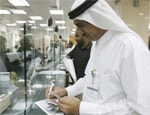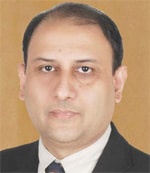The core ethical principles of Islamic finance have protected the industry from the worst effects of the credit crunch.
 |
|
A customer makes a transaction at Emirates Bank in Dubai. |
One segment of the financial markets has been watching the global credit crunch with interest. Islamic financing makes up a small percentage of total global financial assets, but it is a fast-growing segment of the market. Assets are expected to rise from $750 billion at the end of 2006 to more than $1 trillion by 2010. As conventional banks go back to basics, having got their fingers burnt by complex financial instruments, Islamic financing’s exponents believe their investment philosophy is more likely to resonate with banks and investors.
While conventional banks were becoming ever more highly leveraged and dabbling in financial instruments that were not transparent, Islamic financing focused on real assets, which perhaps explains why most Islamic banks have not had to utilize the financial lifelines extended to their conventional counterparts. “Islamic financial institutions are still an attractive proposition and have maintained credit quality,” says Nik Thani, executive director of Islamic finance at the Dubai International Financial Center (DIFC). The general belief is that even if oil prices fall, there is still enough locally held liquidity in the Middle East to avoid the boom-and-bust cycles of old.
One of the key factors in Islamic finance’s resilience, even in the current climate, explains Abdul Rahman Mohammed Al-Baker, executive director of financial institutions supervision at the Central Bank of Bahrain (CBB), is the structure of Islamic products. “They have the physical assets in place,” he says, “be they real estate or other types of assets such as commodities that have real value. With subprime instruments, investors could not understand them.”
Many believe the credit crunch will open investors’ eyes to the potential of Islamic financing. At an Islamic financing congress hosted by State Street in early October in Boston, Zeti Akhtar Aziz, governor of Malaysia’s central bank, Bank Negara Malaysia, stated that Islamic financing continued to be viable and competitive amid the increasingly uncertain global environment and that greater global participation in the development of Islamic finance, both directly and indirectly, would enhance the potential role of Islamic finance in contributing toward global financial stability.
Al-Baker says the interest in Islamic financing continues to grow, spurred on by increased attention from conventional banks that are developing greater volumes of Islamic financial products and establishing separate Islamic banking divisions. Despite some high-profile casualties from the credit crunch in the conventional insurance market, the Islamic equivalent, takaful, continues to grow at a rate of 35% to 40% per year, says Al-Baker, and markets such as Bahrain are attracting some of the big names in takaful and re-takaful, including Western firms such as Allianz and AIG.
Another advantage the Islamic financial market has over conventional markets is its relative immaturity in terms of the complexity and sophistication of Shariah-compliant financial products.
 |
|
Thani: Slowing sukuk issuance demonstrates that Islamic financing is not immune to every form of risk. |
“They are trying to develop Islamic versions of Western products and should not be impacted to the same degree by the credit crunch. As an example, there remains a high degree of skepticism on the applicability of derivatives under Islamic law,,” says Rod Ringrow, senior vice president and managing director of State Street’s Qatar office. Unlike conventional financial instruments, which tend to be developed in isolation, the need to gain approval from Shariah scholars means that Islamic financial products have to jump through a few more hoops before they are deemed fit for purpose and suitable for general market distribution. “Shariah boards constitute a unique form of corporate governance, where a group of people are assigned to look at products, not just in terms of their marketability but also the additional checks and balances of Islamic scholars, which are not just about the bottom line,” says Thani.
It is these checks and balances—and Islamic financing’s core principles of no interest, no speculation or uncertainty, and screening out of highly leveraged stocks—that could prove its biggest appeal. “People with a strong leaning toward social responsibility or ethical investments may find Islamic investments more attractive in this climate,” says Ringrow. Adds Thibaud de Maintenant, head of fund services for Deutsche Bank, “Islamic funds do not permit short selling, so that is an example of where Islamic financing could provide a different perspective.”
But while Islamic financing is based on old-fashioned asset-backed financing, it is starting to reflect the complexity and sophistication that have been the hallmarks of conventional financial markets—until recently. Ijlal Alvi, CEO of the Bahrain-based International Islamic Financial Market (IIFM), made up of central banks and monetary agencies from the Middle East and Asia for the promotion of Islamic capital and money markets, says for liquidity management purposes an Islamic equivalent of repurchase agreements is worth exploring.
Repurchase agreements in the context of Islamic bonds or sukuk were frowned upon by the Bahrain-based Accounting and Auditing Organization for Islamic Financial Institutions (AAOIFI), which stated that sukuks containing repurchase agreements went against the risk-and-reward-sharing principle of Shariah law. “It is a matter of explaining and seeing what [an Islamic repurchase agreement] does,” says Alvi. “If it is properly explained and documented, then I think the majority of Shariah scholars will agree.”
IIFM is also in the final stages of devising a master agreement for the Islamic equivalent of derivatives. While Alvi concedes that derivatives are a “complex issue” in the context of Islamic financing, he says that so far the feedback from Shariah scholars is encouraging. “However, from a Shariah point of view we have to make sure that it is not speculative,” he adds.
While derivatives in Islamic financing are being explored for hedging and risk management purposes, some question how far the Islamic financial industry should go in terms of convergence with conventional financial markets and whether convergence is even desirable, given the current problems in conventional markets. “Islamic financing still needs to be more integrated with global financial markets if it is to achieve global growth,” Alvi asserts.
Thani says new Islamic financial products should not be a mere imitation of conventional products. “The quality of every [Islamic financial] product needs to be looked at carefully,” he says. “There were certain forms of sukuk that were frowned upon by scholars, but that was because they were copying whatever was in the conventional financial market. But in the current market sukuks are structured well, and so far the proof is in the pudding.”
Given the global and systemic nature of the credit crisis, Islamic financing has not escaped totally unscathed. In the current climate the cost of arranging and underwriting sukuk has gone up, says Thani. “It does demonstrate that Islamic financing is not immune to every form of risk, as the cost of doing business is now higher, especially for those sukuk which are attached to Libor,” he says. “If a sovereign issued a sukuk now, it would be oversubscribed, but then you would have to pay more, so definitely we are seeing a slowing in sukuk. We hope the slowdown is temporary, but it is too early to say.”
Sukuk was one of the burgeoning areas of Islamic financing, having grown to an estimated $90 billion, but in September various reports quoting market data said sukuk issuance has halved this year. Alvi of IIFM says that Japan and Indonesia delayed the launch of their sukuks because of what has been happening in the global markets. However, he says that investor appetite for sukuk is still there.
A drop-off in the primary market is also likely to slow development of a secondary market in sukuk. “We are still not seeing a broad investor base,” says Alvi, “and it is likely that we will not see the critical mass we hoped for this year. We will now have to wait until 2009.” Ringrow of State Street says that in the current climate the appetite for setting up MENA (Middle East and North Africa) investment funds may also abate and that family-owned companies may postpone their IPOs until investment conditions improve. “In a world where everything is so interconnected, I cannot see Islamic financing escaping completely,” he says.
 |
|
Alvi: Systemic risk highlights the need for greater cross-border cooperation. |
Calls for more joined-up thinking on which financial instruments are compliant with Shariah law and the need for greater market supervision are likely to be louder in the wake of the meltdown in conventional financial markets. Islamic financial markets in different regions have developed at a different pace based on different schools of Shariah thought and jurisprudence. “Islamic financing regulators tend to work in silos, which is not beneficial,” says Thani. “There is a certain amount of cooperation between different jurisdictions, but this could be improved.”
Roger Harrold, head of domestic custody services at Deutsche Bank, says cooperation between Malaysia and Dubai is facilitating the distribution of Malaysian Islamic funds in the UAE. “If wealth creation continues,” he says, “major Islamic financial population centers such as Malaysia will not be satisfied with just investing in funds in their own country. It seems logical that we will see many more cross-border investments.”
But before that happens, standardization of Islamic financial instruments is essential, and a good example of that is IIFM’s Master Agreement for Treasury Placement (MATP), which can be used by financial institutions in any jurisdiction for over-the-counter (OTC) commodity murabaha transactions. Although commonly used in money markets, commodity murabaha were treated differently in some countries. “Now the commodity murabaha is standard and speaks the same language, but that process needs to be speeded up,” says Al-Baker of CBB.
While the pace of innovation in the Islamic financial market is unlikely to abate even in current market conditions, one lesson all markets can learn from the current crisis is the need for greater transparency and dialogue between regulators in different jurisdictions. “Systemic risk highlights the need for greater cross-border cooperation,” observes Alvi of IIFM. “In the past we have informed different jurisdictions as to what we were doing, but now we are approaching them more directly.”
“It is not just about internal supervision,” Al-Baker adds. “Cooperation and coordination with other regulators gives us the opportunity to hear what is going on in other markets, and it can lead to new ideas such as the setting up of Islamic investment trusts. My dream one day is that we will have an Islamic pension scheme.”
Anita Hawser



